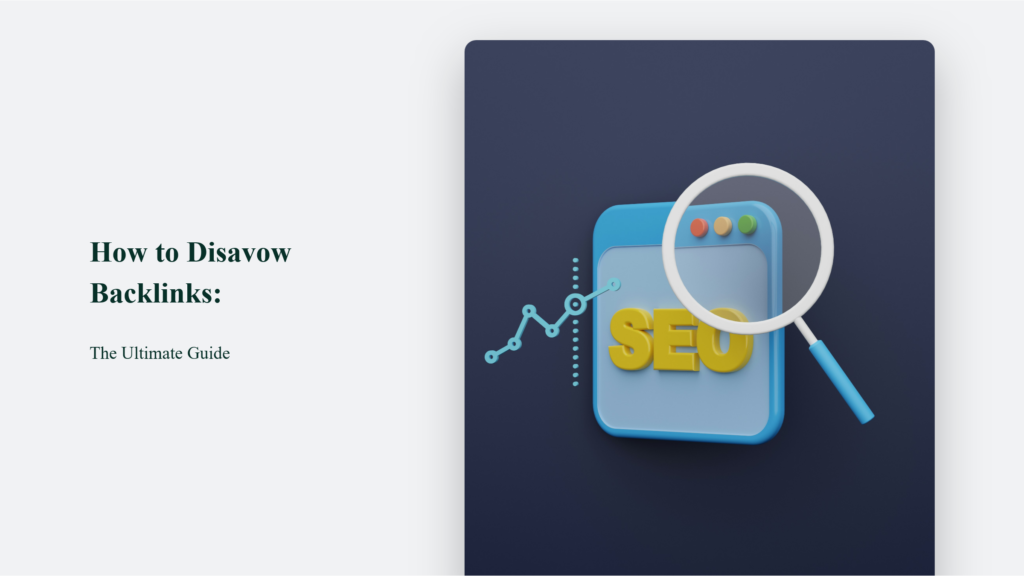

How to Disavow Backlinks: The Ultimate Guide

As Seen On
In the ever-evolving landscape of search engine optimization (SEO), the quality of your backlink profile can make or break your website’s ranking. While backlinks from reputable sources are highly coveted, toxic backlinks can be a ticking time bomb, potentially leading to penalties and a significant drop in your search engine visibility.
It is where the process of disavowing backlinks comes into play – a crucial step in maintaining a healthy and trustworthy online presence. In this comprehensive guide, we’ll dive deep into how to disavow backlinks, exploring their intricacies, best practices, and their potential impact on your website’s SEO performance.

The Importance of Disavowing Backlinks
Imagine you’ve built a beautiful online empire, meticulously crafting high-quality content and implementing sound SEO strategies. However, unbeknownst to you, a few rogue backlinks from questionable sources have found their way into your backlink profile. These toxic links can act like a cancer, slowly eroding your website’s credibility and potentially triggering search engine penalties.
In the past, website owners had to rely on Google’s algorithms to identify and discount these harmful backlinks – a process that was often slow and unreliable. However, with the introduction of the Disavow Tool by Google, webmasters now have the power to take control of their backlink profiles and proactively remove the toxic links that could be holding their websites back.
Understanding the Disavow Tool
Google’s Disavow Tool is a powerful weapon in the fight against toxic backlinks. It allows website owners to submit a list of URLs or domains that they want Google to ignore when evaluating their backlink profile.
By disavowing these links, you’re essentially telling Google, “Hey, I didn’t ask for these links, and I don’t want them associated with my website.” However, it’s important to note that the Disavow Tool should be used judiciously and only when necessary.
Indiscriminate disavowing of backlinks can do more harm than good, as it may inadvertently remove valuable links that are helping your website’s ranking.
Identifying Toxic Backlinks
Identifying toxic backlinks is crucial to maintaining a healthy backlink profile and avoiding potential penalties from search engines. Here are some common signs to look out for when trying to identify toxic backlinks:
Low-Quality or Spammy Websites
Links from low-quality or spammy websites are a major red flag. These sites often have poorly written content, templated designs, and lack information about the website owner or author. They may also have a high percentage of outbound links, indicating a link farm or network.
Irrelevant or Unrelated Content
Links from websites with content completely unrelated or irrelevant to your website can be a sign of a toxic backlink. For example, a link from a website about motorcycles to your computer website may be considered unnatural unless there is a legitimate underlying connection.
Over-Optimised Anchor Text
An excessive number of backlinks with anchor text that exactly matches your target keywords is a red flag for over-optimisation. This unnatural pattern is often a result of paid link schemes or automated link-building tools.
Foreign Language Anchor Text
Backlinks with anchor text in a foreign language that is unrelated to your website’s content can also be a sign of a toxic link.
To identify potential toxic backlinks, you can use various tools and services:
- Google Search Console allows you to see a list of websites linking to your content and can help identify potential issues.
- Ahrefs, Majestic, and SEMrush offer backlink audit features that analyse your backlink profile and highlight potentially toxic links based on their metrics.
- Semrush’s Backlink Audit tool analyses over 45 markers to assign each backlink a Toxicity Score, making identifying and prioritising potentially harmful links easier.
Once you have identified the toxic backlinks, you can contact the website owners to attempt to have them removed. If that fails, you can disavow the links through Google Search Console to prevent them from negatively impacting your search rankings.
How to Disavow Backlinks: The Disavow Process
Once you’ve identified the toxic backlinks, it’s time to disavow them. Here’s a step-by-step guide to the process:
Once you’ve identified the toxic backlinks, it’s time to disavow them. Here’s a step-by-step guide to the process:
Gather the URLs or Domains
The first step is to identify the toxic backlinks you want to disavow. Tools like Ahrefs, Semrush, or Majestic can analyze your backlink profile and flag low-quality or spammy links. It’s generally recommended to disavow at the domain level rather than individual URLs, as this is more efficient and comprehensive.
Format the Disavow File
Google has specific requirements for the disavow file format:
- It must be a plain text file with the .txt extension.
- Each line should contain either a complete URL or a domain to be disavowed.
- You can use the hash symbol (#) to add comments or notes.
For example:

Make sure the file is encoded in UTF-8 or 7-bit ASCII.
Submit the Disavow File
- Log in to your Google Search Console account.
- Select the website property you want to disavow links for.
- In the left sidebar, go to “Security & Manual Actions” > “Disavow links”.
- Click “Disavow links” and upload your formatted .txt file.
- Review and submit the file.
Google will process the disavow file, but it may take some time before the effects are visible.
Monitor and Update
Disavowing links is an ongoing process, not a one-time fix. You should regularly monitor your backlink profile for new toxic links and update your disavow file accordingly.
Some tips:
- Use tools like Ahrefs or Semrush to track new backlinks.
- Set up alerts to be notified of new potentially harmful links.
- Review your disavow file every few months and remove any domains you no longer want to disavow.
- After submitting an updated file, monitor your search rankings and traffic for improvements.
Following this thorough disavow process and staying vigilant can maintain a healthy backlink profile and protect your website’s search engine visibility.
Examples of Toxic Backlinks
Links from Black Hat SEO Websites
Websites that engage in manipulative black hat SEO tactics like cloaking (showing different content to users vs search engines), keyword stuffing, or hidden text are often penalized by Google. Links from such sites are considered toxic as they go against Google’s guidelines.
Links from Link Farms or Networks
Link farms and private blog networks (PBNs) are websites created solely to artificially inflate the number of links pointing to a target site. These links are not editorially placed and provide no value to users. Getting links from known link schemes is a surefire way to end up with toxic backlinks.
Links from Penalized or Flagged Websites
If Google has manually penalized a website for violating its guidelines or algorithmically flagged it for suspicious activity, links from that site can be seen as toxic. Avoid getting links from websites with a history of search engine penalties.
Links from Irrelevant or Off-Topic Websites
Backlinks from websites that do not relate to your industry or niche can also be considered toxic. For example, if you have a pet food website but a large number of your backlinks come from gambling or adult sites, those are likely toxic links. Focus on getting links from relevant, topically related sites.
Links with Over-Optimized Anchor Text
Having an unnatural amount of backlinks that use the exact keywords you want to rank for in the anchor text is a red flag. Called “over-optimization”, this pattern of anchor text manipulation is a common sign of toxic link building. Aim for natural, diverse anchor text instead.
Paid or Sponsored Links that Pass PageRank
Buying links that pass PageRank is against Google’s guidelines. If paying for ads or sponsored content, always use the appropriate rel=”nofollow” or rel=”sponsored” attributes. Otherwise, those paid links could be considered toxic. While the occasional spammy or low-quality link is normal for most sites, having many toxic backlinks is cause for concern. Use tools like Ahrefs, Semrush, or Majestic to audit your backlink profile and identify potentially harmful links.
If you find a significant number of toxic backlinks, try reaching out to the linking websites first to have them removed. For links you can’t get taken down, use Google’s Disavow Tool to ask Google to ignore those links. Just be careful not to disavow any good links in the process.
By proactively monitoring your backlink profile and taking action against toxic links, you can help maintain a healthy link profile and avoid any negative impact on your organic search rankings. Focus on building links naturally from high-quality, relevant websites to stay in the clear.
The Bottom Line:
By following the best practices outlined in this guide and staying vigilant in monitoring and maintaining a clean backlink profile, you can ensure that your website remains in good standing with search engines and continues to rank well for your target keywords.
Frequently Asked Questions:
Will disavowing backlinks negatively impact my website’s rankings?
No, if done correctly, disavowing backlinks should not negatively impact your website’s rankings. The purpose of disavowing is to remove the negative impact of toxic backlinks, which should ultimately improve your rankings.
Can I disavow backlinks from specific pages on a domain?
Yes, you can disavow backlinks at the page level by including the full URL in your disavow file. However, disavowing at the domain level is generally recommended, as this can be more efficient and comprehensive.
How long does it take for the disavow file to take effect?
Google doesn’t provide a specific timeline for when the disavow file will take effect. However, most SEO professionals recommend waiting at least a few weeks to several months before expecting any significant changes in your website’s search engine rankings.
Konger
Up until working with Casey, we had only had poor to mediocre experiences outsourcing work to agencies. Casey & the team at CJ&CO are the exception to the rule.
Communication was beyond great, his understanding of our vision was phenomenal, and instead of needing babysitting like the other agencies we worked with, he was not only completely dependable but also gave us sound suggestions on how to get better results, at the risk of us not needing him for the initial job we requested (absolute gem).
This has truly been the first time we worked with someone outside of our business that quickly grasped our vision, and that I could completely forget about and would still deliver above expectations.
I honestly can't wait to work in many more projects together!
Disclaimer
*The information this blog provides is for general informational purposes only and is not intended as financial or professional advice. The information may not reflect current developments and may be changed or updated without notice. Any opinions expressed on this blog are the author’s own and do not necessarily reflect the views of the author’s employer or any other organization. You should not act or rely on any information contained in this blog without first seeking the advice of a professional. No representation or warranty, express or implied, is made as to the accuracy or completeness of the information contained in this blog. The author and affiliated parties assume no liability for any errors or omissions.

